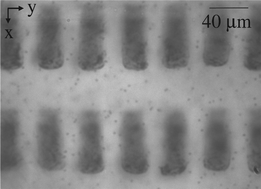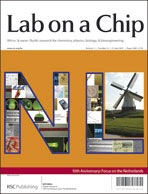Experimental investigation of the flow induced by artificial cilia†
Abstract
The fluid transport produced by rectangular shaped, magnetically actuated artificial cilia of 70 μm length and 20 μm width was determined by means of phase-locked Micro ![[V with combining dot above]](https://www.rsc.org/images/entities/char_0056_0307.gif) cilia = 14 ± 4 μl min−1 in a micro channel of 0.5 × 5 mm2 cross-sectional area when no back pressure is built up. This corresponds to an effective pressure gradient of 6 ± 1 Pa m−1, which equals a pressure difference of 0.6 ± 0.1 mPa over a distance of 100 μm between two rows of cilia. These results were derived analytically from the measured velocity profile by treating the cilia as a thin boundary layer. While the cilia produce phase-averaged velocities of the order of
cilia = 14 ± 4 μl min−1 in a micro channel of 0.5 × 5 mm2 cross-sectional area when no back pressure is built up. This corresponds to an effective pressure gradient of 6 ± 1 Pa m−1, which equals a pressure difference of 0.6 ± 0.1 mPa over a distance of 100 μm between two rows of cilia. These results were derived analytically from the measured velocity profile by treating the cilia as a thin boundary layer. While the cilia produce phase-averaged velocities of the order of  (102 μm s−1), time-resolved measurements showed that the flow field reverses two times during one actuation cycle inducing instantaneous velocities of up to approximately 2 mm s−1. This shows that the flow field is dominated by fluid oscillations and flow rates are expected to increase if the beating motion of the cilia is further improved.
(102 μm s−1), time-resolved measurements showed that the flow field reverses two times during one actuation cycle inducing instantaneous velocities of up to approximately 2 mm s−1. This shows that the flow field is dominated by fluid oscillations and flow rates are expected to increase if the beating motion of the cilia is further improved.

- This article is part of the themed collection: 10th Anniversary: Focus on The Netherlands

 Please wait while we load your content...
Please wait while we load your content...